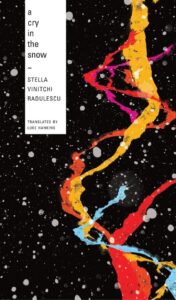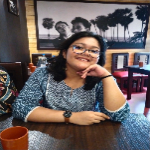A BOOK REVIEW BY SHRESTHA MUKHERJEE
Can the art of poetry stand out to be the subsidiary to the art of living? Keeping aside the words and the symbolic pleasures of the verses, where does one find solace when they stumble upon the nothingness of poetry? Quoting from the Bollywood film Aligarh (2015), doctor Ramchandra Siras said, “As if poetry is in the words? Poetry is found between the words. In the silences…pauses. People can interpret it in different ways… according to their age…maturity…” Evidently, in between the art of living and misery of death, lies the epiphany of poetry, the driving force of survival.
The Romanian poet Stella Vinitchi Radulescu is that embodiment of sensibility who has created her poetry within the gaps, spaces, and vacancies in her writing. Reading Radulescu’s verses is more often an introspective journey that strolls around the void, touching upon the duality of monotony and fulfilment. “Writing poetry was risky,” Radulescu says, “it could have been seen as a ‘political manifesto’ against the regime! –but it was also a refuge.” In her anthology, ‘A Cry in the Snow,’ the poet has honoured the ‘writing’ as a separate entity. A writer of French, English, and her native language Romanian, Radulescu has never translated her works. The translator of the anthology Luke Hankins has shared a quote from Radulescu, where she puts her stand by saying: “I feel, think, act, perceive, smell, touch differently according to the language of I write in.” In other words, the poet has always pinned down her priority over her creation rather than recreation. For this anthology as well, the prioritisation bequeaths by the creation of Radulescu’s eccentricity of poetry rather than her effort, which she did not put for translation. According to Hankins, he said in the translator’s note of the anthology, “Stella Vinitchi Radulescu’s poetry duels in spaces of paradox, seeking out the words, metaphors, and images that capture both the peaceful stillness of snow and the desperate cry of human existence.”
The anthology is a volume of poetries and poetic proses, taken from Radulescu’s French collections ‘Un Cri dans la niege’ and ‘Journal aux yeux fermés’ that the translator has segregated into three distinctive sections. The first section is ‘A Cry in the Snow’ which is a journey of the poet’s surrealism navigating from nature to the physical aspects of humankind. The poem ‘body to body’ rightfully sums up the basic understanding of the entire section: “the tree in place of my thirst/ I plant it in my eyes/ I send its roots/ into my veins”
The idea of deriving nature as a metaphysical concept and merging human existence denotes a conversation between humans and nature to discover each other’s inevitability within this strange yet astonishing world of annotations and communications.
The most denoted poetic element of Radulescu is her utilization of space itself as a poetic element. In the poem ‘just as I fall silent’, the poet personifies the word ‘separation’ both literally and in a definitive manner:
“dances
displaces the air
destroys time
What separates us:
the blue within the reach of the mouth.”
The mannerism of pauses and spaces is one of the key features of Radulescu’s poetry, where she deliberates her reader to halt and mumble the unsaid syllables that hold the extensive significance of her poems. As she has written in her poem ‘here where the body’: “unspoken languages cling/ like vines/ to the body.”
The simple and lucid connotations of these lines reverberate the complex entity of the poet’s mind. The manifestation of sound, line breaks, and description along with the metaphoric titles seems to create imagery. However, when the reader reaches the end of the poetry the whole narration ends up like a loose string, and our journey as readers ends up in a chasing tail. Radulescu has seen the darkness, the pitch-black void within the glee of light. This understanding is carried into the next section of this anthology, ‘Journal with Closed Eyes’ but somehow the dimension of the meaning changes. The uncanny candid flow of unruptured words that flowed out of the genius of Radulescu successfully captured her poetic prose as an example of a ‘stream of consciousness’. The chaotic voiceless shriek in the nothingness loathing out of the monotonous life that goes from one end to the other end focuses on the sheer despair of the poet as many entities a human could have. The poet speculates about her inner turmoil and calmness by going back and forth between her memories and thoughts to her present. The falling section is a collection of prose written in a journal form where Radulescu kept track of her day-to-day life and her mind kept rumbling around her struggle of writing a book. She kept pushing herself to write a book but again seized to remain idle, “The sun through the windows is already making me sweat. The next room over, the children are waking up. The lapping of their little voices.
You could begin a book this way. Or end one.”
However, her journaling halted when Radulescu abruptly stopped building a castle of thoughts and started to invoke the renowned Russian poet Anna Akhmatova whose works also existed between risk and refuge. The poet invokes Akhmatova in the following lines: “And can you describe that? A woman asks Akhmatova in the line in front of the prisons of Leningrad.
Yes I can, she responds.”
These lines were taken from Akhmatova’s poem ‘Requiem” which is a poem about the Political tyranny and the Cruelty of Russian dictatorship. The journal of Radulescu opens with the line “7 November. They assemble us in the Time Square…” The day marks the October Revolution when the Bolshevik party overthrew the Russian monarch and seized power. By invoking Akhmatova, Radulescu seeks her sensible persona to write and be seen lucidly by herself. The poet tries to theorize her ideas that elongated from her troubled memories.
This trouble of being someone and gradually turning into someone else kept stalking the poet and continued her dilemma in the third and final section of the book ‘Fragments of Life and Death.’ In this section, Radulescu moved away from her universe of memories and slowed down in her present state, the reality. The poet questions her every passing moment to be turning as someone else through her lines that describe her experience of attending her book signing event: “…I said, these are the hours I haven’t lived, the circles that never closed because you cut holes in my eyes.” With this line, the life and the tagging claustrophobia of an artist are derived vividly. The dire of living, the monotony of being physically available and prolific swarming ambition choke down the artistic spirit and it dies down along the passage of time. Radulescu seeks a space, for a quiet place that can rejuvenate the voracious cycle of living and dying and desires to meet and return to her entity and soul, which might have got lost somewhere in the way back called ’Life.’ The poet writes: “the trembling white of vowels/ and everything one can’t think any more/ adrift/there are still mouths/ starving/ and bodies that want to be touched/ and bodies that want to be stars..”
Also, read In Conversation With Prabal Kumar Basu, interviewed by Owshnik Ghosh and published in The Antonym:
Follow The Antonym’s Facebook page and Instagram account for more content and exciting updates.



























0 Comments